The Hair of the Ancient Romans Posted by Brittany Britanniae on Oct 12, 2016 in Roman culture, Uncategorized
Salvete Omnes! This week we’re going to focus on the fashions of the Ancient Romans, specifically the way they styled their hair through the generations of fashion and faux pas.
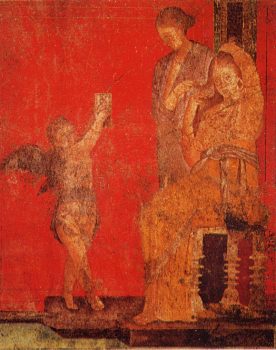
A young woman sits while a servant fixes her hair with the help of a cupid, who holds up a mirror to offer a reflection, detail of a fresco from the Villa of the Mysteries, Pompeii, c. 50 BC. Wikimedia Commons.
Studying the hairstyles seems hardly a dignified task for a historian or for a Latin language-enthusiast, but gaining insight into these ancient trends can be quite interesting and even useful for the historian trying to date a particular piece.
As we know, the Ancient Romans were no strangers to extravagance and luxury, and so it makes sense that a populace that can spare time for very frequent festivals and games and lounging dinners would also have the time to scrutinize and style their appearances. Roman hairstyles were always changing with the times. Women, much as they might be considered to do today, used their hairstyles to indicate their individuality. Much like today’s fashion trends what might be considered a beautiful arrangement of locks one year may very well be considered outdated and unattractive the next.
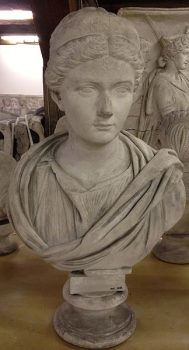
Sabina’s signature hairstyle marked a departure from the elaborate, multi-layered hairstyles of the Flavian and Trajanic periods. In accordance with her husband Hadrian’s love of all things Greek, she was most often depicted with a simple coiffure meant to resemble that of Greek goddesses. Her wavy hair is parted in the center, brushed back into a loosely braided bun at the back of her head and crowned with a lunate diadem at the front. Wikimedia Commons.
Because of these distinct trends historians can tell if a piece of artwork is from one era or another with otherwise little evidence to help them. Anyone who is familiar with Roman sculpture portraits will remember the Flavian Woman.
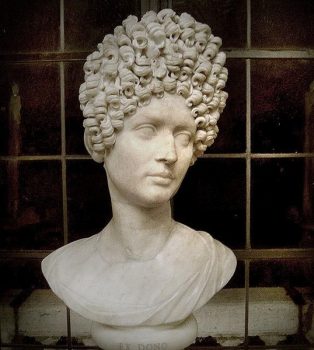
Portrait of a woman of the Flavian period, marble // Portrait bust of a young woman (Julia, daughter of Titus?). Marble. 80s—90s A.D. Shows ultra-elaborate hair styles worn by upper-class Roman women of the time. Courtesy of Wikimedia Commons.
From the first century, during the Flavian dynasty, this style is perhaps the most famous. Her hair is braided tightly and firmly coiled into submission behind her head, which greatly contrasts the sudden and extravagant volume and wildness of her bangs, if that’s what we might call them. Intensely curled her hair climbs itself into a voluminous wall that crowns her face with confidence. One might wonder how this style was not only achieved but maintained throughout the day or through a festival or party.
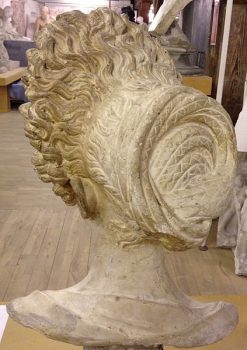
Portrait of a woman of the Flavian period, marble // Portrait bust of a young woman (Julia, daughter of Titus?). Marble. 80s—90s A.D. Shows ultra-elaborate hair styles worn by upper-class Roman women of the time.
Before the Flavians were the Augustan era styles. These styles followed a methodical understanding of hair. This understanding was the nodus style. The parts of hair were three, with the hair from the sides of the head tied in a bun at the back while the middle section is looped back on itself.
Before the Augustan were the Tutulus styles in the 6th and 5th centuries BCE. This is probably the beginning of Roman fashion as it was a style derived from Etruscan fashion. This style was worn by the mother of the family, or the materfamilias. To achieve it, the hair was divided and brought up into a high bun, peeking over the crown of the head. The bun was anchored and tied with purple fillets of wool. After the styling was completed, the hair should be conical in shape. It was also the hairstyle worn by the priestesses, the flaminicae.
You can see this style brought to modern times in this video!:
Another use of knowing Roman hairstyles is how a style identifies the social standing of the person. The use of accessories, such as golden hairnets, would certainly send a statement of affluence in style.
Keeping with the times of fashion was so important for some Ancient Romans that when they ordered a portrait bust to be made they required that it be rendered bald. Although wigs were also fashionable in Rome, this was not because the person was actually bald. This is because they would order “marble wigs” for their bust.
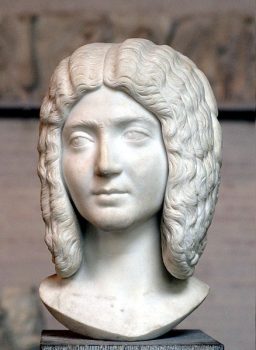
Portrait of a Roman lady, ca. 200 CE. The shape of the face and the hairstyle look like the empress Julia Domna (wife of Septimius Severus, mother of Geta). Hair is probably a wig. Wikimedia Commons.
As the fashion trends came and went they could have a wig, carved from marble, made for their bust so that it was never outdated. Even their sculptured likeness could stay up-to-date at a fraction of the cost it would have taken to get an entirely new bust every time trends changed. These particular fashion-lovers must have displayed these busts very proudly and observed, very closely, their standing in society as fashionable people.
This is only the tip of the iceberg that is the cultural significance of hairstyles in Ancient Rome, but it is an interesting insight into the daily lives, trends, and ideals of the Ancient Romans who prided themselves in recognizing and creating beauty. If anything, this could give some of you an idea or two about potential Halloween costumes, or maybe you’d like to bring these styles back and give these busts another shot at being, after all these years, in vogue.

Build vocabulary, practice pronunciation, and more with Transparent Language Online. Available anytime, anywhere, on any device.
About the Author: Brittany Britanniae
Hello There! Please feel free to ask me anything about Latin Grammar, Syntax, or the Ancient World.



